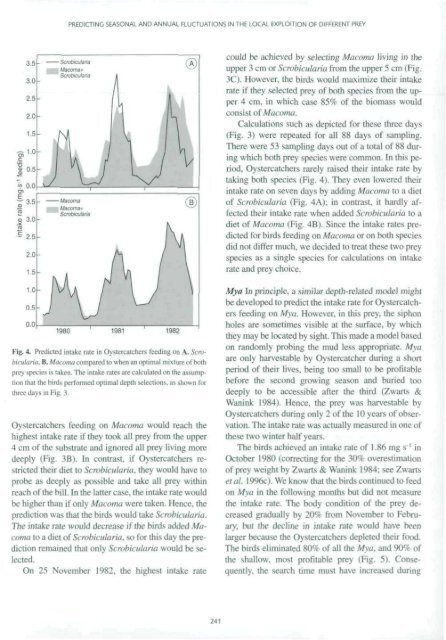waders and their estuarine food supplies - Vlaams Instituut voor de ...
waders and their estuarine food supplies - Vlaams Instituut voor de ...
waders and their estuarine food supplies - Vlaams Instituut voor de ...
You also want an ePaper? Increase the reach of your titles
YUMPU automatically turns print PDFs into web optimized ePapers that Google loves.
PREDICTING SEASONAL AND ANNUAL FLUCTUATIONS IN THE LOCAL EXPLOITION OF DIFFERENT PREY<br />
1980 1981 1982<br />
Fig. 4. Predicted iniake rale in Oystercatchers feeding on A. Scrobicularia.<br />
B. Macoma compared lo when an optimal mixture of both<br />
prey specie- is taken. The intake rates are calculated on the assumption<br />
that the birds performed optimal <strong>de</strong>pth selections, as shown for<br />
three days in Fig. 3.<br />
Oystercatchers feeding on Macoma would reach the<br />
highest intake rate if they took all prey from the upper<br />
4 cm of the substrate <strong>and</strong> ignored all prey living more<br />
<strong>de</strong>eply (Fig. 3B). In contrast, if Oystercatchers restricted<br />
<strong>their</strong> diet to Scrobicularia. they would have to<br />
probe as <strong>de</strong>eply as possible <strong>and</strong> lake all prey within<br />
reach of the bill. In the latter case, the intake rate would<br />
be higher than if only Macoma were taken. Hence, the<br />
prediction was thai the birds would take Scrobicularia.<br />
The intake rate would <strong>de</strong>crease if the birds ad<strong>de</strong>d Macoma<br />
to a diet of Scrobicularia. so for this day the prediction<br />
remained that only Scrobicttlaria would be selected.<br />
On 25 November 1982, the highest intake rate<br />
241<br />
could be achieved by selecting Macoma living in the<br />
upper 3 cm or Scrobicularia from the upper 5 cm (Fig.<br />
3C). However, the birds would maximize <strong>their</strong> intake<br />
rate if they selected prey of both species from ihe upper<br />
4 cm, in which case 85% of the biomass would<br />
consist of Macoma,<br />
Calculations such as <strong>de</strong>picted for these three dav s<br />
(Fig. 3) were repeated for all 88 days of sampling.<br />
There were 53 sampling days out of a total of 88 during<br />
which both prey species were common. In this period.<br />
Oystercatchers rarely raised <strong>their</strong> intake rate by<br />
taking both species (Fig. 4). They even lowered <strong>their</strong><br />
intake rate on seven days by adding Macoma to a diet<br />
of Scrobicularia (Fig. 4A); in contrast, it hardly affected<br />
<strong>their</strong> intake rate when ad<strong>de</strong>d Scrobicularia to a<br />
diet of Macoma (Fig. 4B). Since the intake rates predicted<br />
for birds feeding on Macoma or on both species<br />
did not differ much, we <strong>de</strong>ci<strong>de</strong>d to treat these two prey<br />
species as a single species for calculations on intake<br />
rate <strong>and</strong> prey choice.<br />
Mya In principle, a similar <strong>de</strong>pth-related mo<strong>de</strong>l might<br />
be <strong>de</strong>veloped to predict the intake rate for Oystercatchers<br />
feeding on Mya. However, in this prey, the siphon<br />
holes are sometimes visible at the surface, by which<br />
they may be located by sight. This ma<strong>de</strong> a mo<strong>de</strong>l based<br />
on r<strong>and</strong>omly probing the mud less appropriate. Mya<br />
are only harvestable by Oystercatcher during a short<br />
period of <strong>their</strong> lives, being too small to be profitable<br />
before the second growing season <strong>and</strong> buried too<br />
<strong>de</strong>eply to be accessible after the third (Zwarts &<br />
Wanink 1984). Hence, the prey was harvestable by<br />
Oystercalchers during only 2 of the 10 years of observation.<br />
The intake rate was actually measured in one of<br />
these two winter half years.<br />
The birds achieved an intake rate of 1.86 rags in<br />
October 1980 (correcting for the 30% overestiination<br />
of prey weight by Zwarts & Wanink 1984; see Zwarts<br />
et al. 1996c). We know that the birds continued to feed<br />
on Mya in the following months but did not measure<br />
the intake rate. The body condition of the prey <strong>de</strong>creased<br />
gradually by 20% from November to February,<br />
but the <strong>de</strong>cline in intake rate would have been<br />
larger because the Oystercatchers <strong>de</strong>pleted <strong>their</strong> <strong>food</strong>.<br />
The birds eliminated 80% of all the Mya. <strong>and</strong> 90% of<br />
the shallow, most profitable prey (Fig. 5). Consequently,<br />
the search time must have increased during

















